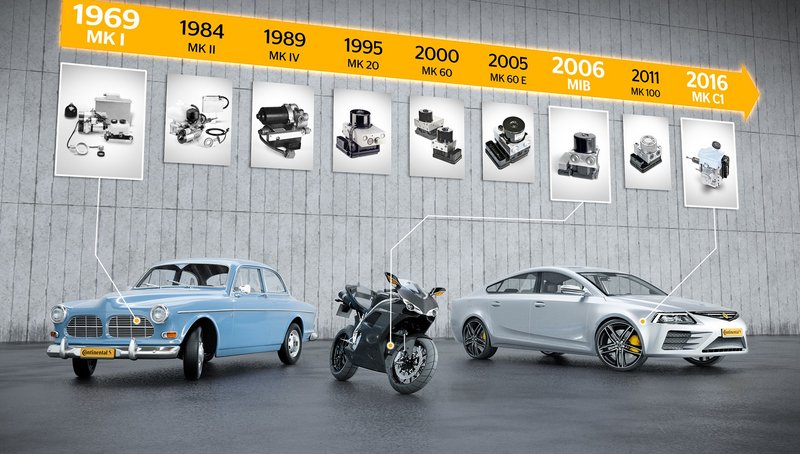Major Safety System Anniversary: 50 Years of Continental Anti-lock Brakes
- In 1969, Continental presented an Anti-lock brake system (ABS) for the first time
- Continuing further development ever since – current systems have up to 50 additional functions
- ABS is the central safety system and is critical to the implementation of Vision Zero, crash-free driving
Auburn Hills, Mich., October 2, 2019. Back in 1969, the automobile industry was booming and the technology company Continental presented a world premiere: ITT-Teves showcased the MK I, the first anti-lock brake system (ABS).
The idea of preventing car wheels from locking when braking hard so the car could continue to be steered had already occurred to vehicle designers in the 1920s. However, a solution to the problem only emerged with the development of powerful electronics. Starting in 1965, engineers at Teves (later ITT-Teves) – which became part of Continental in 1998 – worked on an ABS for passenger cars. Starting in the 1970s, integrated circuits based on analogue circuit technology were used to regulate brake pressure and prevent the wheels from locking. The system was presented 50 years ago in 1969.
A technological breakthrough
The technology was initially only used in 36 test vehicles for the Swedish police. The global oil crisis and subsequent weakening of the economy, which hit the automotive market particularly hard, prevented series production for years. Finally, in 1984, a technological breakthrough: unlike competing systems that were already on the market, Teves launched the MK II, the world's first microprocessor-controlled ABS for passenger cars on the road. In North America it was available for the Lincoln Continental, while in Europe this safety technology became a standard feature of the Ford Scorpio. Its installation in the factory was another novelty, since at that time ABS was usually only available as an optional feature for a significant surcharge.
"Due to its programmability, our system could be quickly and optimally validated both for braking maneuvers on rough roads, that is, with a high coefficient of friction, and for those on slippery roads, such as on ice in winter,” explained Helmut Fennel, formerly with Continental and who played a key role in promoting the use of microprocessors for ABS. “It was also considerably more flexible than other solutions and could be quickly adapted to different vehicle concepts, such as models with front-wheel or all-wheel drive. The microprocessor solution gave us a several-year head start."
ABS as a central safety system
The MK II was the first ABS on the market to combine the brake function, brake booster, hydraulic control and anti-lock brake system into one compact unit. A traction control system (TCS) was also integrated shortly afterward. An important milestone in the development of ABS was the later MK IV system, which went into series production in 1989 and, for the first time, included an electronic brake force distribution system, making mechanical-hydraulic components unnecessary. Continental's developers took another developmental leap forward in 1995 when electronic stability control (ESC) was integrated into the MK 20 system for the first time. In this new arrangement, which has become the worldwide standard, the engine is located at the top, the valve block in the middle and the electronics below as the base. Continental anti-lock brake systems are still based on this principle, with the modularity of the equipment variants (ABS, ABS + TCS, ESC) optimally meeting customer requirements.
An ABS today is equipped with up to 50 additional and safety functions, such as the automatic release of the parking brake when shifting in to gear, hill start assist or as an important component of adaptive cruise control systems. All that in just 2 kilograms (4.4 lbs) and taking up the same amount of space as a single-lens reflex camera. The first production-ready ABS from Continental was the size of a 5-liter (1.3-gallon) gas can and weighed 11.5 kilograms (25.4 lbs).
Over the past 50 years, ABS has become the universal chassis control system for longitudinal and lateral dynamics, as a result of further developments that eventually led to ESC. Since the system can individually control the braking force for each wheel, it is indispensable for current and future cross-vehicle control systems. It is also a condition for further safety technologies, like advanced driver assistance systems (ADAS), and enables the next steps towards automated driving. The future of ABS technology will mainly be determined by software innovations – for more comfort and even more safety.
ABS technology saves countless lives
The introduction of ABS has significantly improved road safety, with other factors such as the seat belt and the introduction of speed limits playing a role alongside the spread of ABS. Since 2013, the system, in conjunction with ESC, has been required by law for all new cars throughout the U.S. Since the introduction of the first systems at the end of the 1970s, the total number of people killed on U.S. roads has fallen by nearly 30 percent. Additionally, according to a report by the Insurance Institute for Highway Safety, ABS was associated with a 31 percent reduction in the rate of fatal motorcycle crashes. In general, it is difficult to overestimate the safety advantage of controlled vehicle deceleration in dangerous situations while maintaining steering control.
ABS and other active and passive safety technologies are important milestones in achieving the long-term goal of Vision Zero, a future without traffic crashes. To further support this goal, earlier this year, Continental launched #SafelyThere, an initiative designed to increase consumer trust in ADAS and automated safety technologies – the building blocks of automated driving and a world without traffic crashes. Learn more about this initiative, including how you can get involved, by visiting the #SafelyThere website and engaging in the #SafelyThere discussion on Facebook and LinkedIn.
Continental develops pioneering technologies and services for the sustainable and connected mobility of people and their goods. Founded in 1871, the technology company offers safe, efficient, intelligent and affordable solutions for vehicles, machines, traffic and transportation. In 2018, Continental generated sales of €44.4 billion and currently employs more than 244,000 people in 60 countries and markets.
The Chassis & Safety division develops and produces integrated active and passive driving safety technologies as well as products that support vehicle dynamics. The product portfolio ranges from electronic and hydraulic brake and chassis control systems to sensors, advanced driver assistance systems, airbag electronics and sensor technology as well as electronic suspension systems all the way to windshield washer systems and headlight cleaning nozzles. The focus lies on a high level of systems expertise and the interconnectivity of individual components. Thus products and system functions are developed along the SensePlanAct chain of effects. They form the foundation for automated driving. Chassis & Safety employs more than 49,500 people worldwide and generated sales of approximately €9.6 billion in 2018.

Mary Arraf
Head of Communications Automotive and Continental North America



